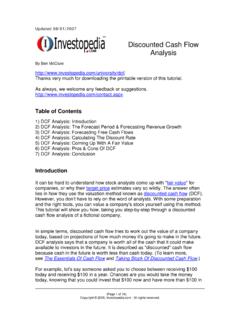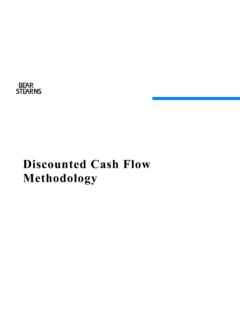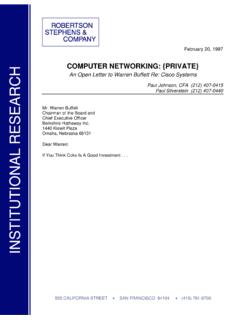Transcription of Graham and Doddsville
1 First time I had ever heard of warren buffett . I figured since Lynch was talking to buffett , I should learn more about who buffett is. I looked around, and found the first two biographies that had just been published: Lowenstein s The Making of an American Capitalist and Hag-strom s The warren buffett Way. I read those books and I just had an epiphany. They reso-nated strongly with me. The thing that I found very strange was that if there is such a thing as the laws of investing, warren buffett has pretty much laid them out. What I couldn t un-derstand was that when I looked at the entire mutual fund industry at the time, which were the professional managers that I had exposure to, I saw that these guys not only did not follow the fundamental laws of investing, but most of them didn t even know what they were.
2 At the same time, their results reflected sub-par per-formance. So I thought there must be a correlation between these guys not following the rules and having poor perform-ance. The second thing I found very strange was how you can have an entire industry which does not function with a solid frame-work. To me, it is like people doing brain surgery by just winging it . That is how I saw mutual funds work they were just winging it, or they come up with any nuance or flavor of the day they want to pursue. I had a thought that if novices like me simply adopted buffett s ap-proach and invested in the eq-David Kessler, MBA 2008 Mohnish Pabrai launched Pabrai Funds in 1999.
3 Less than a dec-ade later, Mr. Pabrai s name is often mentioned in the same breath as legendary value inves-tors who have been in the busi-ness for decades. The Pabrai Funds annual shareholder meet-ing has become a stop on a value investing tour that in-cludes the annual meetings of Berkshire Hathaway, Wesco, and The Sequoia Fund. He is also a frequent guest of Bloomberg, CNBC, and The Value Investing Congress. In 2007, Mr. Pabrai published his second book, The Dhandho In-vestor, which is quickly becoming a must read for all value inves-tors. Last year, along with Guy Spier, manager of Aquamarine Fund, Mr. Pabrai was the highest bidder in an eBay auction for lunch with warren buffett .
4 With his daughters sitting on either side of buffett , Mr. Pabrai, Mr. Spier and their families spent the afternoon of July 25 with their mentor. In April, Mohnish made his first appearance at Columbia Busi-ness School where he appeared as the guest lecturer in Profes-sor Bruce Greenwald s Value Investing Seminar. Mr. Pabrai s investment style has not only been influenced by Benjamin Graham , warren buffett , and other value investors, but also by the Indian approach called Dhandho. When asked about his investment philosophy, he often repeats the mantra Heads I win, tails I don t lose that much. Graham and Doddsville was lucky enough to sit down and delve deeper into Mohnish Pabrai s investment philosophy.
5 Question: How did you get started with value investing? Until I was 30 years old, frankly, I had never heard of Mr. buffett . I had never heard of value in-vesting. This was 1994 and I was vacationing in London with my wife. I was looking for something to read on the flight back to Chicago, and I picked up one of Peter Lynch s books. I am an engineer by training, so this was a different field for me. I read that book on the flight and I loved it. It made all the sense in the world to me, In terms of how to and how not to invest. I thought this was an interesting area and I wanted to know more about it, so I found that Peter Lynch had another book and I read that one too.
6 I wanted to learn even more, but I ran out of Peter Lynch books to read. I remembered that in one of the books, Peter Lynch mentioned warren buffett and told a story of how buffett had called him to get his permission to use a quote. This was the Making Heads and Tails of Mohnish Pabrai Summer / Fall 2008 Graham and Doddsville An investment newsletter from the students of Columbia Business School uity markets with a concen-trated portfolio, etc. that I was likely to do better than most of the industry professionals. So I said it was worth testing this hypothesis out. I was lucky at the time in 1994; I had about $1 million in cash. I had just sold some assets of my business and I decided to go ahead and manage that in a buffett -style concen-trated portfolio, buying things I understood, etc.
7 That is how I got into value investing. Question: You have man-aged Pabrai Funds since 1999. That must have been quite a time to open a value fund. Actually, 1999 was very interest-ing. I think it was a great time to start as a value investor be-cause the market in 1999 and 2000 had segregated. As a mat-ter of fact, on the day that the NASDAQ hit its peak, Berkshire hit its 52-week low. What hap-pened is that a lot of money had gone into these frothy dot-com type stocks, but effectively it had Volume II, Issue 2 Mohnish Pabrai Pabrai Investment Funds such as the Fairholme Fund, Marty Whitman, Einhorn, and all of those folks. That is basi-cally where I go fishing. Question: What are char-acteristics of the compa-nies that attract you?
8 In general, I look for industries with a slow rate of change, companies with some type of moat, and companies with hard assets. I look to buy businesses where I can rest my hat on the hard assets of the business. Other times, I look at busi-nesses that have more of a franchise value, so the intrinsic value is made up more of intan-gibles such as brand, etc. Basi-cally, what I m trying to do is find businesses that I can buy well below what they are worth. I usually try to make one bet per industry, and I typically put 10% of the fund s assets into each idea. An ideal portfolio would be comprised of 10 positions from 10 differ-ent industries all priced at a discount to what they are worth.
9 In terms of what ex-actly I focus on is determined by what is on sale. Question: Once you iden-tify a potential investment idea, what is your process for determining whether it is in fact a good invest-ment? After I identify an interesting company, I begin to drill down reading the 10K s and 10Q s. When I first come across a business, I generally ask myself within the first few minutes: Is this something I understand well? Is this a relatively straight-forward business to understand? If I am not getting a clear idea in my head of how the business works and how it makes money, then I will gen-erally stop and move on to the next business.
10 In fact, I often move on if I can t answer that question right way. So the first question you have to ask your-self is: In general, is this a busi-ness I can understand? I made an investment in 2001 in a company called Stewart Enter-prises which is in the funeral services business. I can under-stand that business. You bury people, cremate them, you get paid, etc. Then you can start to think about understanding the finer points, such as the brand, and what people think about the community of funeral service providers. It is not a business where a competitor can open up overnight with cheaper pricing and just take your business away. Then, there is the fact that it is rare for someone to aspire to go into the funeral business.












